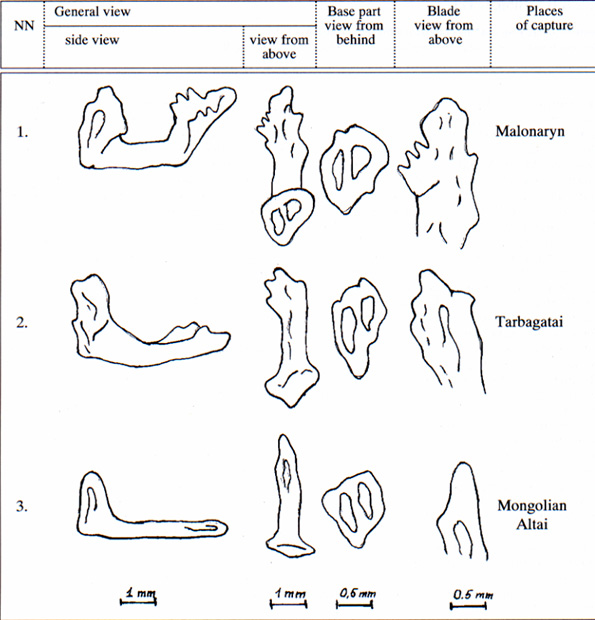Schema. Changes of the grey marmot's/Marmota baibacina/baculum

ritorno/back
INTRASPECIFIC BACULUM VARIABILITY IN GREY MARMOT
Pole S.B.°, Bibikov D.I.*
°Middle-Asian Plague-central Research institute, Alma-Ata.
*Research institute of Evolution Morphology and Ecology, Moscow. USSR.
The morphological structure of more than 120 baculums of grey marmot from different parts of the area has been investigated. The Tien Shan subspecies was represented by samples from the Aksai, Vorkhnonaryn, Malonaryn, Kokpak-sarydzhaz, Kungei-Zailiysk populations; and the Altai subspecies was represented by samples from the Tarbagatai, Saur and Ukok. Grey marmot from the Mongolian Altai was represented by samples from the Kobdo and Ulan-Daban populations.
Measurements have been taken according to the schema above mentioned (Pole et al., 1983): the full baculum length; the length, width and thickness of its base parts, shaft and blade; shaft curve and axis; the number and level of the blade denticle manifestation, and the shape of separate parts.
The analysis of the data obtained indicates the relative stability of such signs as the base deviation angle to the shaft axis, the blade manifestation and its denticled equipment, the shaft curve and base shape proved to be variable to great extent.
The tendency to simplifying the entire baculum structure in the west-east direction of the species area was found. It is manifested in the smaller shaft curve; the blade deviation angle to the shaft axis decreases from 60-70 degrees practically to zero; the blade edges get smooth and the blade size decreases; the number of the blade denticles is reduced from 3-5 to 1-2 with the simultaneous smoothing down of the blade shape (the Mongolian Altai).
The characteristic feature of marmots in the South Altai (Tarbagatai, Saur, Ukok) is the oval-shaped base, which is confirmed in V. Kapitinov's (1969) investigation while the extremely spiral-like baculum (the base is significantly deviated to the right and the blade - to the left of the shaft axis) is characteristic of the animals in the Verkhnenaryn population. The degree of the variability of the investigated factors within the compared populations is much lower than that of the regional populations, which makes it possible to define the discovered variability as clinal.
Â
VARLABILITÀ INTRASPECIFICA DEL BACULUM NELLA MARMOTTA GRIGIA
Pole S.B.°, Bibikov D.I.*
°Middle-Asian Plague-central Research institute, Alma-Ata.
*Research institute of Evolution Morphology and Ecology, Moscow. USSR.
É stata analizzata la struttura morfologica di oltre 120 baculum di Marmotta grigia provenienti da aree diverse. La sottospecie del Tien-Shan era rappresentata da campioni appartenenti alle popolazioni di Aksai, Vorkhnonaryn, Malonaryn, Kokpak-.sarydzhaz e Kungei-Zailiysk; la sottospecie dell'Altai era rappresentata da campioni provenienti da Tarbagatai, Saur e Ukok. Per quanto riguarda le marmotte grigie dell'Altai mongolo sono.stati prelevati campioni dalle popolazioni di Kobdo e Ulan-Badan. Le misurazioni sono state effettuate secondo la schema riportato in bibliografïa (Pole et al., 1983): lunghezza totale del baculum; lunghezza, altezza e spessore delle parti basali, dell'asta e della lama; curvatura e corda dell'asta; caratteristiche e dentellatura della lama.
L'analisi dei dati indica una certa stabilità di alcuni caratteri, quali ad esempio l'angolo formato dalla base con l'asse dell'asta; al contrario le caratteristiche della lama e la sua dentellatura, la curvatura dell'asta e la forma della base si sono dimostrate piuttosto variabili. É stata messa in evidenza una tendenza alla semplificazione dell'intera struttura del baculum andando da ovest a est nell'areale di distribuzione della specie. Tale semplificazione si manifesta con una riduzione della curvatura dell'asta; una variazione dell'angolo sotteso tra lama e asse dell'asta, che varia da 60-70° a circa 0°; una modificazione dei bordi della lama, che si arrotondano, riducendosi di dimensioni; una diminuzione del numero dei dentelli della lama, che passano da 3-5 a 1-2, mentre l'asta nel suo complesso si fa più liscia (Altai mongolo).Il carattere morfologico specifico delle marmotte dell'Altai meridionale (Tarbagatai, Saur, Urkok) é la forma ovalare della base, cosi com'é confermato dalle ricerche di V Kapitinov (1969); mentre il baculum decisamente spiraliforme (la base é decisamente deviata a destra e la lama a sinistra, rispetto all'asse dell'asta) é caratteristico degli animali che appartengono alla popolazione del Verkhnenaryn. Il grado di variabilità registrato all'interno di ciascuna popolazione analizzata é molto inferiore rispetto a quello esistente tra le diverse popolazioni a livello regionale e questo ci permette di definire la variabilità evidenziata come di tipo clinale.
Schema. Changes of the grey marmot's/Marmota baibacina/baculum

REFERENCES
KAPITONOV, V.I. 1969. Mlekopitajuschie Kazakhstana. Alma-Ata, t.I, ch. 1, 267-336.
POLE, S.B., MJAGMARZHAV, D., SMIRIN, lu. M., GORBUNOVA, A.V. 1983. Kvoprosu o sistematicheskom poloshenyi surkov Khangayai Mongolskogo Altaya. Mater. soveschaniya po surkam, M. 1983. 86-69.
Tornare index / back contentsÂ